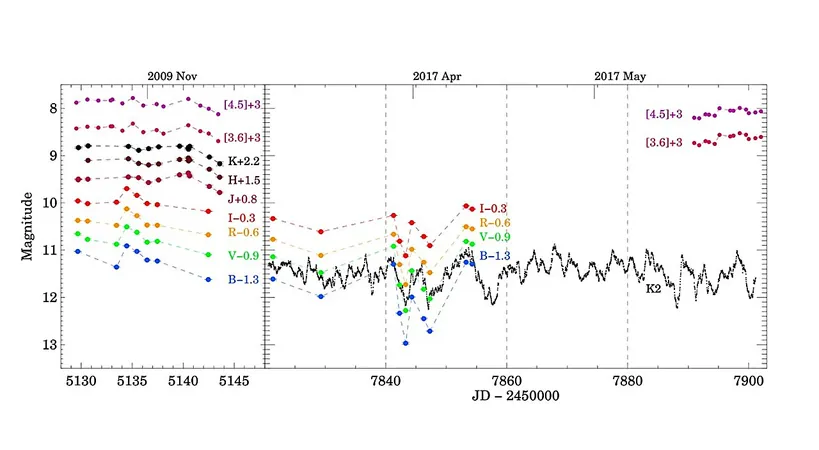
Unveiling the Secrets of DR Tauri: A Young Star's Mysterious Variability
2025-05-20
Author: Jia
Astronomers Explore the Enigmatic DR Tauri!
A groundbreaking investigation into the young star DR Tauri has unveiled its mesmerizing variability, capturing the attention of astronomers worldwide. Utilizing advanced technologies from both ground-based and space telescopes, a dedicated international team has shed light on the intricate nature of this fascinating star.
What is a T Tauri Star?
DR Tauri belongs to a thrilling category of stars known as Classical T Tauri Stars (CTTSs), which are newly formed, low-mass entities still enveloped by their protoplanetary disks. These stars are characterized by dramatic fluctuations in brightness and distinctive emission lines, leading to both unpredictable and cyclical variations.
Meet DR Tauri!
Situated in the Taurus star-forming region approximately 610 light years away, DR Tauri boasts a spectral type ranging from K5 to M0, a radius about 1.46 times that of our Sun, and an estimated effective temperature of 4,100 K. Its enigmatic behavior has piqued the interest of researchers for decades, showcasing various irregular light changes over numerous timescales.
Groundbreaking Observations!
Under the leadership of Gabriella Zsidi from the Konkoly Observatory in Budapest, astronomers have embarked on a mission to capture DR Tauri's variability through multi-filter observations. These observations, incorporating data from notable space telescopes like Kepler and TESS, confirmed that DR Tauri's light fluctuates dramatically across all monitored timescales.
Key Findings: A Symphony of Light!
The data revealed that the light curves of DR Tauri are predominantly influenced by unpredictable changes, with a typical variability timescale of around 2 to 3 days. Interestingly, while the light curves maintained a similar shape across different filters, the intensity of the fluctuations diminished as wavelengths increased.
Mysterious Signals and Accretion Insights!
Despite efforts to pinpoint a reliable rotational period for DR Tauri, the team's analytical methods did not yield conclusive results. However, a tantalizing hint of a periodic signal emerged, suggesting cycles of approximately three days. Furthermore, the study highlighted striking complexities within the hydrogen-alpha line, indicating significant variations in the star’s accretion flow and wind.
What’s Causing These Variability Mysteries?
The researchers believe that the intriguing short- and long-term variability of DR Tauri is a result of several factors: accretion processes, stellar winds, and obstructive circumstellar matter. As astronomers continue to investigate the nuances of this young star, DR Tauri offers an exciting window into the dynamic processes of star formation.

 Brasil (PT)
Brasil (PT)
 Canada (EN)
Canada (EN)
 Chile (ES)
Chile (ES)
 Česko (CS)
Česko (CS)
 대한민국 (KO)
대한민국 (KO)
 España (ES)
España (ES)
 France (FR)
France (FR)
 Hong Kong (EN)
Hong Kong (EN)
 Italia (IT)
Italia (IT)
 日本 (JA)
日本 (JA)
 Magyarország (HU)
Magyarország (HU)
 Norge (NO)
Norge (NO)
 Polska (PL)
Polska (PL)
 Schweiz (DE)
Schweiz (DE)
 Singapore (EN)
Singapore (EN)
 Sverige (SV)
Sverige (SV)
 Suomi (FI)
Suomi (FI)
 Türkiye (TR)
Türkiye (TR)
 الإمارات العربية المتحدة (AR)
الإمارات العربية المتحدة (AR)